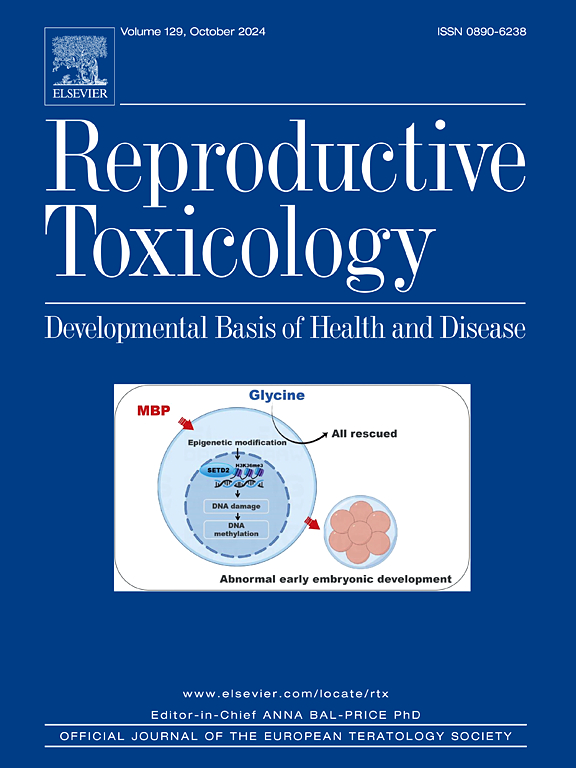Modeling lamotrigine-induced reprotoxicity in porcine endometrial organoids: Integrated multi-platform profiling
IF 3.3
4区 医学
Q2 REPRODUCTIVE BIOLOGY
引用次数: 0
Abstract
Lamotrigine, a newer generation anti-epileptic drug aimed at addressing reproductive complications, requires thorough evaluation of its effects on the endometrium. Using the three-dimensional endometrial organoid (EO) model provides a distinct advantage in modeling lamotrigine-induced toxicity, offering a more relevant physiological system. In this study, a porcine EO model was used and treated with lamotrigine to mimic and analyze drug-induced toxicity. Porcine uteri were processed and digested with collagenase, then combined with Matrigel and incubated with 5 % CO2 environment, at 38°C. During passaging, cells were dissociated, treated with trypsin-EDTA, and subcultured, with the medium renewed every 2–3 days. Different analytical methods were employed to evaluate lamotrigine's impact on the endometrial organoids, covering aspects such as cell viability, morphology, replication, steroidogenesis, and metabolic changes. The results showed significant alterations in cell morphology with a decrease in number and size. Metabolite analysis revealed metabolic shifts in some amino acids, glucose and galactose, ranging from approximately 1.5 to 5 times, (p < 0.05), when compared to the control groups. Molecular assays indicated increased oxidative stress, activation of apoptotic pathway, and disrupted steroidogenesis, revealing lamotrigine as an active endocrine disruptor. Moreover, lamotrigine induced changes in specific miRNAs that regulate implantation, and epithelial-mesenchymal transition pathways. In conclusion, our study highlights the potential diverse impact of lamotrigine on the endometrial microenvironment, emphasizing the need for further investigations into its implications on reproductive health and embryo implantation.
拉莫三嗪诱导的猪子宫内膜类器官生殖毒性建模:综合多平台分析
拉莫三嗪是一种新一代的抗癫痫药物,旨在解决生殖并发症,需要彻底评估其对子宫内膜的影响。使用三维子宫内膜类器官(EO)模型在模拟拉莫三嗪诱导的毒性方面具有明显的优势,提供了更相关的生理系统。本研究采用拉莫三嗪处理猪EO模型,模拟并分析了药物毒性。用胶原酶对猪子宫进行处理和消化,然后与Matrigel结合,在5 % CO2环境下,在38℃下孵育。传代过程中,分离细胞,用胰蛋白酶- edta处理,传代,每2-3 天更换一次培养基。采用不同的分析方法评估拉莫三嗪对子宫内膜类器官的影响,包括细胞活力、形态、复制、甾体生成和代谢变化等方面。结果显示细胞形态发生了明显的变化,细胞数量和大小都有所减少。代谢物分析显示,与对照组相比,某些氨基酸、葡萄糖和半乳糖的代谢变化约为1.5至5倍(p <; 0.05)。分子分析显示氧化应激增加,凋亡通路激活,类固醇生成中断,揭示拉莫三嗪是一种活跃的内分泌干扰物。此外,拉莫三嗪诱导了调节着床和上皮-间质转化途径的特定mirna的变化。总之,我们的研究强调了拉莫三嗪对子宫内膜微环境的潜在影响,强调需要进一步研究其对生殖健康和胚胎植入的影响。
本文章由计算机程序翻译,如有差异,请以英文原文为准。
求助全文
约1分钟内获得全文
求助全文
来源期刊

Reproductive toxicology
生物-毒理学
CiteScore
6.50
自引率
3.00%
发文量
131
审稿时长
45 days
期刊介绍:
Drawing from a large number of disciplines, Reproductive Toxicology publishes timely, original research on the influence of chemical and physical agents on reproduction. Written by and for obstetricians, pediatricians, embryologists, teratologists, geneticists, toxicologists, andrologists, and others interested in detecting potential reproductive hazards, the journal is a forum for communication among researchers and practitioners. Articles focus on the application of in vitro, animal and clinical research to the practice of clinical medicine.
All aspects of reproduction are within the scope of Reproductive Toxicology, including the formation and maturation of male and female gametes, sexual function, the events surrounding the fusion of gametes and the development of the fertilized ovum, nourishment and transport of the conceptus within the genital tract, implantation, embryogenesis, intrauterine growth, placentation and placental function, parturition, lactation and neonatal survival. Adverse reproductive effects in males will be considered as significant as adverse effects occurring in females. To provide a balanced presentation of approaches, equal emphasis will be given to clinical and animal or in vitro work. Typical end points that will be studied by contributors include infertility, sexual dysfunction, spontaneous abortion, malformations, abnormal histogenesis, stillbirth, intrauterine growth retardation, prematurity, behavioral abnormalities, and perinatal mortality.
 求助内容:
求助内容: 应助结果提醒方式:
应助结果提醒方式:


